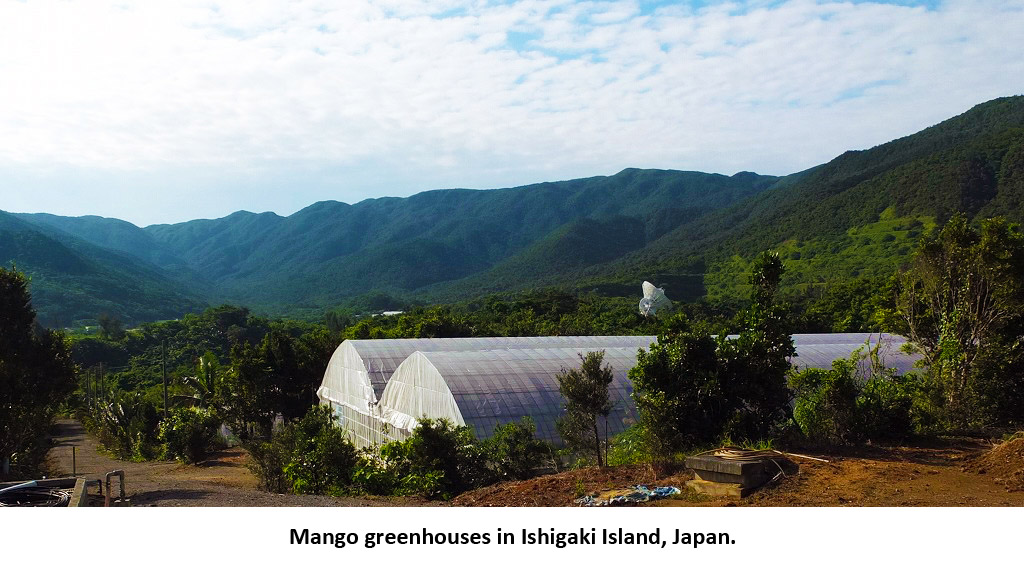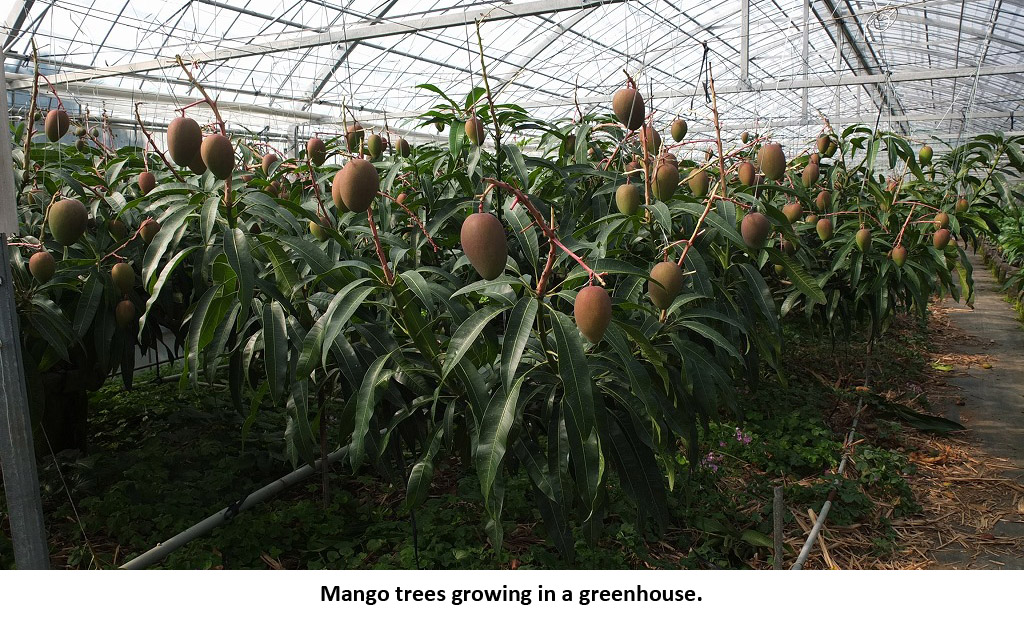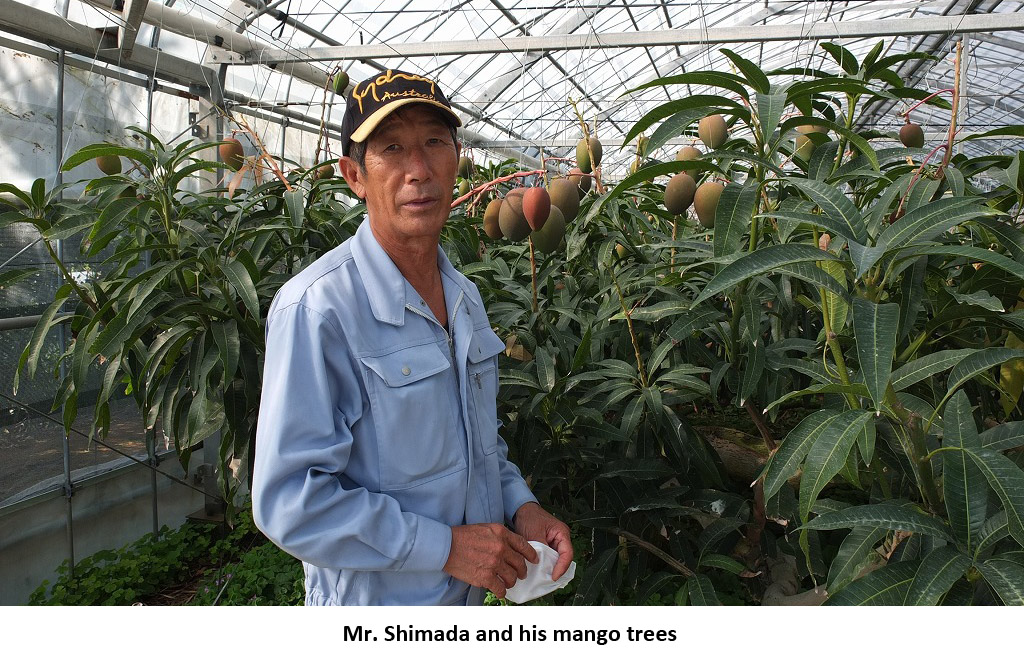Ishigaki Island is a part of the Yaeyama Islands, located southwest of Okinawa Prefecture. It is 410 km away from the main island of Okinawa and 1,950 km away from Tokyo City. With an area of 222.6 square meters, this small island is famous for its mangoes. In summer, mango fruits produced from this Ishigaki are shipped to all parts of Japan.
Background
Mango trees were introduced to Ishigaki from Taiwan in the 1930’s. While they are only 277 km apart, the trees did not initially bear fruit because of the different in climate. Unlike Taiwan, Ishigaki receives a huge amount of rainfall during the mango flowering season that inhibited fruit setting.
In the early 1980’s, Ishigaki city government embarked on a strategy to develop the mango industry. They established mango nurseries and distributed grafted plants to farmers. Farmers also studied mango cultivation and succeeded in producing fruits by covering mango trees with plastic sheets to protect from rain. This method eventually led to the development of greenhouses, which is currently the common practice for mango cultivation in the island.
Fruitfly eradication programs
Although farmers successfully produced mango, the prevalence of oriental fruit fly (Bactrocera dorsalis) and melon fly (Bactrocera cucurbitae) in the island prevented distribution to the rest of Japan.
According to the Okinawa Plan Protection Center, oriental fruit fly has been reported in the Okinawa Islands since 1919 but is believed to have been widely distributed throughout the Prefecture. A project to exterminate oriental fruit fly was completed in Ishigaki Island in 1986. Wood chips soaked in pheromones and insecticides were used to lure and kill male flies.
The Okinawa Plant Protection Center first reported the existence of melon fly in Yaeyama Islands in 1919. Ishigaki Island eradicated the pest in 1993 through a large-scale government initiative. Massive amounts of sterilized male and female flies were irradiated with gamma rays and released to reduce the population.
Profile of a POTORIKA-MANGO (‘Erwin’) producer
Ishigaki Island produces ‘Erwin’ cultivar, which they rebranded as ‘POTORIKA-MANGO’ by farmers. In Japanese, ‘POTORI’ is the sound of dropping and ‘KA’ means ‘fruits’. This name is derived from Erwin’s unique tendency to drop ripe fruits. Some mango cultivars occurs physiological damage when fully ripen on the tree, but Erwin occurs it very few. Farmers bag the fruits one by one to catch fully ripen Erwin fruits.
‘Erwin’ has very mild flavor, which the Japanese people prefer. The POTORIKA-MANGO is considered premium grade mango among Japanese consumers.
Nagamasa Shimada grows POTORIKA-MANGO in his 0.5 ha farm. Shimada cultivates 215 trees varying from ages 5, 10, 15 and 25 years old. The production area for mango is covered with greenhouses to ensure fruit set. Plants are hence maintained to about 1.5 m in height and 8 m wide, which also eases harvesting. His farm producing 8 tons of premium grade fruits in 2012. However, the production has been affected by climate, especially by typhoons. Yield of premium grade can reach as high as 12 tons, but dropped to 3 tons in 2006 even his orchard was surrounded by windbreakers. That typhoon winded up to 67 m/s hit Ishigaki Island. To prevent damage when the next typhoon hits, Shimada improved his greenhouse. His greenhouse already had one layer of windbreak net on the greenhouse frame, but he set another layer on the upper part of the canopy with 2 m high.
Shimada spends a lot of time in the orchard to ensure premium grade fruits, which uniformly weighs 450g. Because mango fruits that grow under the leaves develop poor color, Shimada orients the fruits to a suitable position, resulting in better color.
With the excellent quality, Shimada’s fruits are in high demand. If you want to taste his mango fruits, you should be very lucky. Most of his fruits in this season are already reserved even before harvesting!
Article by Dr. Naoko Kozai and Tatsuki Ogata, Japan International Research Center for Agricultural Sciences (JIRCAS)




Hi Mr Shimada,
Im is mango grower in Mexico and I’m interested in visiting your greenhouse. Please let me know when is the best time for you to receive us.
Thank you
Arigato gozaimasu
You have developed very good farm,but productivity of Mango in G.H. may be low !
If You want to develop in India ,we can provide you Plate-form for it, on export profit sharing basis.
Thanks
Is the “Erwin Cultivar” is the same mango called Irwin in USA. Where did Japan “Erwin” mango originate from? Can I obtain Erwin mango scions (budwood)?
Are the mango trees grown in pots? Do they prune the roots? How often? What are their maintenance program? How tall is their 25 yrs. old trees? Can you send me more information?